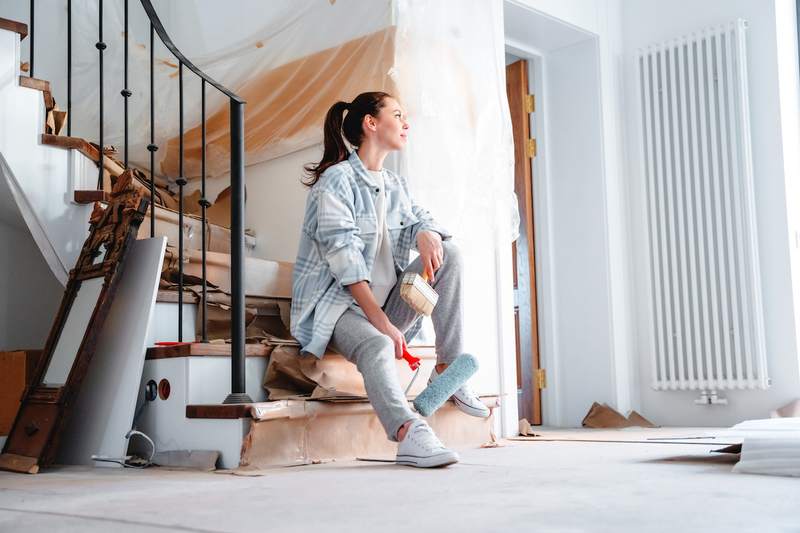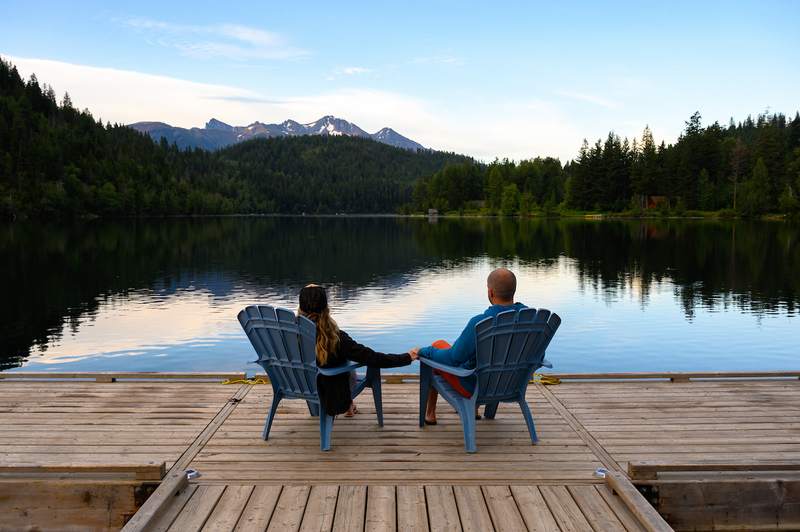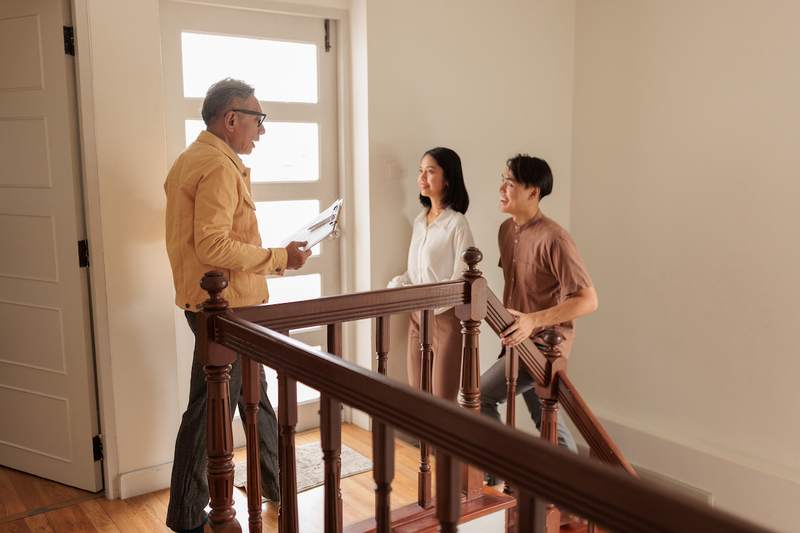Buying an existing home comes with a lot of potential drawbacks, especially for first-time homebuyers. An older home can require extensive repairs, it could be too small or too large for you, the layout might not fit your family’s lifestyle, and the location may be inconvenient.
Building a home from scratch can solve many of those problems. You can customize your living space, the amenities, the layout, and every other detail of the home as you build it from the ground up.
However, building a home is time-consuming and expensive. Fully understanding the steps involved, the common pitfalls, and things that might go wrong can help you better navigate the process.
Key Takeaways:
- Building your own home lets you customize your living space to your exact desires.
- Be ready for surprises and budget overruns.
- The process can take a long time — often nine months or more.
Stage 1: Preconstruction
Before you can start building your home, you need a place to build it, and you need to know what you want to build. Preparing for the long process that is building a home can help you avoid many pitfalls down the road.
1. Buy a lot
The first step is finding and buying a plot of land. You’ll likely want to work with a real estate agent on this. They can help you locate and make an offer on available lots.
While it’s easiest to build on an empty lot, you could buy a preexisting home, tear it down, and then build a new home. Expect this to be a far more expensive option.
The cost of an empty lot will vary based on where you live. Nationally, the median price is $55,000, but you can buy a lot in some rural areas for as little as $3,000.
Buying bare land is a bit different than buying a property with a preexisting home. If financing is required, you likely need a specialized land loan. These are designed for buying empty lots, and typically have stricter credit requirements than mortgages.
2. Decide what type of home to build
Once you’ve located a lot, you need to decide what type of home you want to build on it.
Most likely, you’ll be planning for a single-family home. There are many basic home designs to choose from. Depending on local laws and the size of your lot, you may be able to build a multifamily home.
Next, you will need to choose an architectural style, such as a ranch or a Cape Cod. You’ll want to consider both what you like and where you live. If you live in a climate with snow, a Pueblo-style home with a flat roof might not be the best choice and could look out of place in the neighborhood.
You can research much of this on your own. You can tour the area you plan to build in for inspiration, or you may want to work with an architect on a custom design.
3. Hiring a building team
Once you have a plan, you need a team to execute it. Look for experienced builders and contractors who specialize in the type of home you want to build.
“You need to determine what is most important to you in your new home. For us it was a builder who specialized in energy-efficient homes,” says Marcella MacKenzie, a former real estate agent from Meredith, New Hampshire, who built her own home. “We also visited a few different construction sites by different builders. Finally, it came down to whose estimate was cheapest.”
Another thing to consider is experience with local laws. Regulations and building codes can vary from state to state and even town to town, says Whitney Hill, co-founder of SnapADU, a San Diego-based accessory dwelling unit builder.
“Your builder should be able to provide insight into what those regulations are and how they might affect your build,” she says.
4. Get required permits
Permits are required for any type of major construction. Exactly which permits you need, and how much they cost, depends on local law.
For example, Framingham, Massachusetts, charges $15 per $1,000 of construction costs for residential building permits — plus additional fees for demolition permits and a certificate of occupancy once the home is built.
The timeline for getting these permits also varies, but you can expect it to take a week or longer.
5. Clear the property
Before you can build on a lot, you need to clear away any previous structures, wildlife, trees, plants, and anything else that could impede construction.
Expect to hire professionals to remove obstacles such as large rocks and tree stumps using machinery. If your lot is already rather bare, you may be able to manage the task on your own.
The price to clear your lot will depend on the size. Typical prices range from $1,565 to $4,520, but clearing an eighth of an acre will only cost between $101 and $734, while clearing a five-acre lot could cost as much as $29,000 or more. Permit costs and the complexity of clearing the lot also affect pricing.
Depending on size and complexity, clearing a lot could take anywhere from one day to a week or longer.
Stage 2: Foundation
The next step is to lay the foundation of your new home. This is one of the stages where expensive surprises can pop up.
“One issue that can arise is that sitework costs end up being higher than expected,” says Hill. “This is particularly true for raw land, which can require a significant amount of improvement before building can commence. This may include installing utilities, improving drainage, or making right-of-way improvements that involve expensive, specialized contractors.”
6. Level the site
The first thing you’ll need to do is make sure your lot is level. You need as flat a surface as possible for your foundation.
As always, prices depend on the size of the lot and where you live. The price could range from 8 cents to $2 per square foot of space you need graded. Typical grading jobs take a few days to a week.
7. Prepare the land for the foundation or basement
Once the land is level, you can start preparing it for your foundation. This includes any final clearing of debris and rocks, setting up a wooden template for the foundation, and digging holes and trenches around the property. If you want a well for your home, the construction crew will dig it at this stage. This is a time when problems often appear.
“Something we encounter is the ‘unknowns,’” says Michael DiGiorgio, an assistant superintendent at Greystar, a Boston-based construction and property management firm. “Some homes may need to be designed differently for high water tables, or we could start excavating and hit (a) ledge, which adds to the schedule and adds cost.”
8. Install footings
Footings are the structures that connect your home to the earth that supports it. These are often concrete or metal structures that spread the load of the foundation over a larger area.
Footings for your home can range in price from $225 to $3,600. Footings can be installed in a day or two, but you may need to wait for the footings to cure if you use concrete, which can take as long as 28 days.
9. Pour the foundation
Once you have the footings in place, you’re ready to pour the foundation for your home.
The cost will depend on the type of foundation you’re installing and the design of your home. On average, homes with crawl spaces will see foundation costs of $5 to $16 per square foot, while homes with basements will see prices from $10 to $25 per square foot.
Once the concrete is poured, you’ll have to wait for it to cure. Curing can take a long time, and timelines will vary based on temperature. The colder it is, the longer concrete takes to cure.
Partial curing takes 24 to 48 hours, and the foundation can likely handle most loads after a week. Full curing can take a month or more.
10. Install drains, sewers, and taps
Once the foundation cures, it’s time to install the first-floor plumbing. These lines will go through the trenches that were dug before the foundation was laid, and will handle bringing water in and out of your home.
A typical price range for a sewer line installation is $1,325 to $5,320, with costs varying based on how far the lines need to run. Installation can take between one and three days.
11. Waterproofing and plumbing
Your building team will finish any other plumbing required for your home’s first floor and fill in the trenches to cover the pipes. They’ll also apply waterproofing to the foundation and anywhere else that needs it.
Waterproofing for a home with a basement can cost $3 to $10 per square foot on average and take a few days.
12. Foundation inspection
The foundation needs to be inspected before you can build on it. This inspection ensures that the foundation is sturdy, safe, and compliant with local building codes.
The cost of an inspection will depend on where you’re located, but expect it to cost $350 to $500. The inspection might take a few days to a week or more to schedule, and require an hour or two to complete.
Stage 3: Framing
The foundation serves as the base for your home to stand on, but framing is what makes your home really start to take shape.
13. Rough framing
Framing the structure is one of the longest steps of building a home, taking anywhere from a week or two to multiple months depending on the size and complexity of your design, weather conditions, material availability, and more. It can cost anywhere from $15,000 to $50,000 to frame a home.
14. Sheath and wrap exterior walls
After framing, the construction team will apply plywood sheeting or strand board sheathing around the exterior walls and roof, and wrap the sheathing in a moisture barrier. This step is usually included in the price and timeline of framing.
15. Install windows and exterior doors
After framing, you can install the windows and doors of your home. These can be surprisingly expensive, especially if you opt for energy-efficient models.
Expect windows to cost anywhere from $800 to $1,900 or more. Exterior doors, especially patio doors, can cost thousands of dollars each. Installation can take 30 to 60 minutes per window, and door installations take about four hours each.
Stage 4: Plumbing, Electrical, and HVAC
With your home framed and insulated from the elements, construction on interior aspects of your property can begin in earnest.
16. Install the HVAC system
Heating, ventilating, and air conditioning systems often require the installation of large components, such as compressors, furnaces, and heat pumps, as well as ductwork that goes throughout the house.
Costs for HVAC can be high, especially if you add more efficient or complex systems. However, prices also vary by location. For example, people in warm climates might be able to skip on some heating systems.
An HVAC system with ducts can cost between $7,000 to $16,000. Installation can take a few days to a week or two.
17. Complete rough plumbing
Installing the pipes and plumbing can take three to five days to complete, assuming there are no delays caused by weather or other issues. The process usually costs about $7,000 for a single bathroom.
18. Install electrical wires and panels
Because it’s easier to work wires around ducts and pipes, the electrical panel and wiring are usually installed after the HVAC and plumbing systems.
Prices can vary massively depending on the size of your home, its electrical needs, and whether you want to add solar panels, batteries, or car chargers.
For a basic installation, it can cost between $4 and $9 per square foot. That means a 1,500-square-foot home would cost at least $6,000 to wire up, and a 2,500-square-foot home could cost up to $22,500. It may take one to three weeks to complete.
19. Inspections
You’ll need to get all the major systems of your new home inspected as you complete them, and before you seal them behind walls or other surfaces. Timelines and pricing will depend on where you live.
For example, the city of Malden, Massachusetts, charges $300 for permits and inspections on new-home wiring. Additional inspections, such as for air conditioners or heating units, cost more.
Stage 5: Insulation and Drywall
The next phase of the homebuilding process is to insulate the home and install drywall for the interior walls and ceilings.
20. Install insulation
Insulation is important for keeping your home warm in the winter and cool in the summer, and for reducing heating and cooling costs.
Pricing depends on the material you use for insulation, and ranges from 30 cents to $1.50 per square foot for fiberglass insulation, to $6.75 per square foot for wood fiber insulation. You can usually finish this process in a day or two.
21. Hang drywall
Drywall will cover almost the entire interior of your home, forming the walls and ceilings you’ll see every day, and enclosing insulation, plumbing, and wiring behind a solid surface.
The price will depend mostly on the size of your home, with average costs ranging from $1.30 to $4 per square foot. Rooms with high ceilings or that need unusual shapes could increase the price.
Given the amount of effort and labor involved — hiring a drywall professional will cost $50 to $100 per hour — drywalling a home could take a month or more.
22. Texture walls and ceilings
Drywall usually has a very bland, smooth finish. Adding texture gives it more character and can make the interior of your home more appealing.
Texturing doesn’t take very long and usually costs about $1 to $2 per square foot. Prices will vary depending on the type of texturing you choose.
Stage 6: Interior and Exterior Finishes
Once the home is framed, you’ve installed essential systems to make the place livable, and you’ve hung the walls and ceilings, you can start on the more detailed interior work.
23. Paint the walls
Painting the walls of your home will cost between $1 and $3 per square foot. Prices depend on the amount of labor you hire, the type of paint you use, and how many coats you want painted. Adding trim and ceiling paint can increase the cost to as much as $5 per square foot.
Painting a full home interior can take three to five days.
24. Install flooring and countertops
You’ll want to install hard flooring and counters in areas like kitchens and bathrooms. You may also want to install hard floors in other parts of your home.
Materials and labor for hardwood floors or tile can range from $6 to $10 per square foot or higher depending on which materials you use and where you live. Counters will cost more, ranging from $50 to $150 per square foot and up. Edge and corner treatments can cost more.
It typically takes a few weeks to install flooring in your home.
25. Install bathroom fixtures
You’ll need to install sinks, showers, and toilets in each of your home’s bathrooms and connect them to the plumbing you laid earlier in the homebuilding process.
Depending on the models you select, typical price ranges for bathroom fixtures are:
- Toilets: $400 to $800.
- Sinks: $400 to $1,000.
- Showers: $1,000 to $7,000.
- Bathtubs: $3,000 to $7,000.
You also can expect to pay a few thousand dollars for vanities, countertops, and cabinets. Installation will take a few days.
26. Install mirrors and shower doors
Mirrors cost about $10 per square foot, so you can expect to spend a few hundred dollars — unless you’re getting a luxury mirror. Shower doors usually cost $1,000 to $3,000. Installation for both of these can finish within a day.
27. Complete interior trim
Trim makes the interior of your home look more appealing and adds definition to each room. It involves a lot of detail work, so it can take some time to install.
Most trim will cost $2 to $5 per foot, but some types — such as crown molding or wall framing — can cost as much as $25 per foot. It can take about a day of work to install 125 feet of trim.
28. Install walkways and driveway
A basic concrete driveway will cost about $2,000 to $7,000, and take up to three days to build. Walkways will come at an additional cost, which depends on their size.
29. Complete mechanical trims
Finishing mechanical trims means laying the final groundwork for installing electrical and plumbing fixtures, as well as appliances and other equipment that go into your home.
30. Install cabinets and vanities
Cabinets and vanities offer valuable storage space in a kitchen or other areas of your home. Prices vary widely. Outfitting a kitchen with cabinets can cost between $2,000 and $20,000, depending on the number and quality of cabinets. A single, basic cabinet will cost about $250 to install.
Installing cabinets and vanities usually takes anywhere from a few days to a couple of weeks.
31. Install light fixtures, outlets, and switches
You’ll want ample access to light and electricity in your home, so you’ll need to place light fixtures, switches, and outlets around the space.
Adding light fixtures will cost about $100 per fixture for basic ceiling lights. Recessed lights or chandeliers can cost up to $2,000. Outlets could cost as little as $75 or as much as $450 each, but usually cost about $250 each.
The installation process could take days or a couple of weeks, depending on how many outlets and fixtures need to be installed.
32. Exterior finishing
Exterior finishes — such as siding, window shutters, and other details — can keep your home protected from the elements and give it a nice look.
Depending on the siding and finishes you choose, the price can range from $2 to $50 per square foot, though the average is on the lower end of the range at $12 per square foot. A typical home will cost about $10,000 to $15,000 to side and finish.
Expect the process to take a few weeks, plus additional time if you’re painting anything.
33. Exterior grading
Your lot should have a slight downward slope away from your home to prevent water from pooling around your foundation and possibly getting into your home. You’ll spend about $2 per square foot that needs grading.
34. Exterior landscaping
Landscaping can give the exterior of your home a welcoming feel and add curb appeal. The cost will vary widely depending on what you’re looking for. A basic lawn, for example, will cost much less than a large garden.
Expect to pay between $3,000 and $15,000 for landscaping, though extreme projects could cost as much as $40,000 if you want to jump into the deep end of landscaping. Typical timelines for landscaping are a few days to a few weeks.
Stage 7: Final Steps
Once your house is fully constructed, there are a few steps you need to take before you can move in.
35. Final home inspection
The final home inspection involves letting a local government inspector into the home to examine every last detail of the completed construction. They will make sure that the home is safe, and the building is up to code.
The inspector will examine everything from the grading of the lot and the location of the chimney to whether the handrails are properly installed and the stairs are well illuminated. If the inspector notices any issues, you’ll need to be ready to fix them as quickly as possible.
A full inspection can take some time to schedule and usually lasts a few hours. Price will vary with your location but is usually about $500.
36. Final walk-through
The final walk-through, also called a blue-tape walk-through, usually happens about three or four weeks after the home is completed. During this walk-through, you’ll meet with someone who represents the building company, such as a builder’s agent or the foreman.
You’ll then get to tour the home and examine it to make sure it meets your expectations and requirements. This is your last chance to bring up any concerns. Be on the lookout for uneven floors, foundation cracks, and other defects.
37. Closing on the home
If your home passes inspection and you’re satisfied during your final walk-through, it’s time to close on the home.
Closing day usually arrives six to nine months after you’ve started your homebuilding journey. The closing process begins up to 60 days before you actually sit down and sign the paperwork. During this time, you’ll shop around for a loan if you haven’t already secured one, get homeowners insurance, and have a lawyer look over the closing paperwork.
The actual closing process where you sign paperwork likely will take a few hours.
FAQ: Building a House Step by Step
Here are answers to some frequently asked questions about building a home.
It can take as long as nine months or more from the time you buy land to the moment you move into your new home.
Average costs range from about $112,000 to $460,000 or more. They vary massively depending on where you live. The price of labor and the lot will be some of the biggest influences.
If qualified, you can finance some of this through loans.
“We had a bridge loan to pay the down payment to the builder. But primarily we had a construction loan,” MacKenzie says. “The builder had a contract that required payments at various stages of construction, and the bank holding the construction loan paid the builder. Once the home was finished, we got a mortgage that paid off the construction loan.”
Whether existing homes or new homes are cheaper depends on where you’re looking to live. Typically, it’s cheaper to build a new home in places where home prices are already high. However, labor and land costs could limit the savings.
“I truly believe with the cost of homes right now and how people are overpaying for a house, building a brand-new house may be more feasible to people than they expect,” DiGiorgio says.
The Bottom Line on Building a House Step by Step
Building a home is an often uncertain project that takes a lot of time and money. Since your home is being put together from scratch, any number of issues could significantly delay completion or increase the cost. There are many steps involved, as well as many professionals required to make sure your home is built well. The payoff for your patience and hard work, however, is a home that is fully and completely yours.
More From LowerMyBills:
- Important Questions First-Time Homebuyers Should Ask Lenders
- How To Compare Mortgage Offers
- How Much Down Payment Do You Need To Buy a Home?
- Buying a Fixer-Upper: What You Need To Know
- How To Get a Mortgage in 10 Steps
- What You Need To Know About Buying a New-Construction Home






